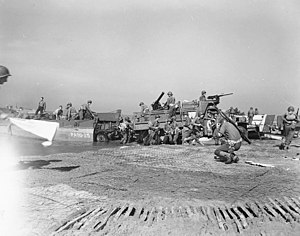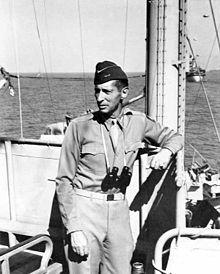Allied invasion of Italy
| date | September 1943 |
|---|---|
| place | Southern Italy |
| output | Allied victory after German withdrawal |
| consequences | Italy leaving the war |
| Parties to the conflict | |
|---|---|
| Commander | |
| Troop strength | |
| 190,000 soldiers | 100,000 soldiers |
| losses | |
|
12,500 |
3,500 |
1940–1945: Air raids on Italy
1940: Attack on Taranto
1943: Operation Husky - Invasion of Italy ( Baytown , Avalanche , Slapstick ) - Armistice of Cassibile - Fall of the Axis
1944: Battle of Monte Cassino - Operation Shingle - Position of Goth
1945: Spring Offensive
The Allied invasion of Italy in World War II was a landing operation by the Western Allies on the Italian mainland in September 1943. It followed the landing in Sicily ( Operation Husky ). The main Avalanche operation took place near Salerno in Campania and aimed to capture the port of Naples . As a result, this landing led to Italy's withdrawal from the war. Southern Italy had to be evacuated by the German Wehrmacht .
prehistory
At the Casablanca Conference in early 1943, British Prime Minister Winston Churchill tried to convince US President Franklin D. Roosevelt of the idea of starting the attack on "Fortress Europe" with an attack from the south on Sicily. Churchill argued that in order to proceed further, it was necessary to secure the shipping lanes in the Mediterranean. In addition, Italy could be moved in this way to leave the front of the Axis powers . At the Trident Conference in May 1943 it was agreed in principle to continue operations in the Mediterranean region in 1943 with the aim of bringing Italy out of the war. This should improve the prospects of Operation Roundup , which was planned for 1944 , as the German army would be forced to deploy additional divisions to occupy the Balkans and defend northern Italy and southern France. The Allied Commander in Chief at the Mediterranean Theater of Operations General Dwight D. Eisenhower was then assigned to work out options for follow-up operations for Operation Husky . The Americans originally favored a landing in Sardinia and Corsica and an intensification of the aerial warfare , the British favored a landing on the Italian mainland with the option of later building a beachhead in Albania .
Operation Husky against Sicily began on July 10, 1943 and was successfully completed by mid-August. At the suggestion of the American Chief of Staff George C. Marshall , planning began in mid-July for an undertaking to take the port of Naples under the name Operation Avalanche .
After the Italian dictator Benito Mussolini was ousted after a meeting of the Grand Fascist Council on July 25th, his successor Pietro Badoglio began negotiations on a separate peace with the Allies. At the Quadrant Conference in August 1943, Churchill and Roosevelt decided to continue operations on mainland Italy.
The German high command had previously decided to station additional German divisions in northern Italy and near Rome in order to be able to disarm the Italian army in the event of a separate peace between the new Italian government. The plans for this and for the takeover of the Italian occupation areas in the Balkans and in south-east France were worked out under the heading “ Case Axis ”.
plan
While the 7th US Army remained in Sicily, the British 8th Army , also involved in Husky , commanded by General Bernard Montgomery , and the 5th US Army deployed in North Africa , commanded by General Mark W. Clark , were responsible for the landings chosen and combined in the 15th Army Group . The British Field Marshal Harold Alexander , who was also Eisenhower's deputy, was in command .
Opposite them stood the German 10th Army General Heinrich von Vietinghoff under the Commander-in-Chief for Southern Italy GFM Albert Kesselring . It was reinforced in August by the units of the XIV Panzer Corps evacuated from Sicily .
Due to the impending departure of Italy from the war, the Allied commanders decided to carry out the main landing on the west coast of Italy. The landings in Calabria across the Strait of Messina and in the Gulf of Taranto were planned as ancillary operations that should make the German defense more difficult.
The British 8th Army was to land on September 3rd from Messina on the opposite coast of Calabria near Reggio Calabria ( Baytown ). This operation could be carried out with light landing craft due to the short distance .
The Gulf of Salerno south of Naples was selected as the landing point for the main landing ( Avalanche ) planned a week later , as better conditions were to be expected there than in the also considered estuary of the Volturno northwest of Naples. For this purpose, the 5th US Army, consisting of the American VI Corps and the British X Corps with the 82nd US Airborne Division, were selected as reserves , which were transported by sea from North Africa. A plan to use the 82nd Division to occupy airfields near Rome ( Operation Giant II ) was dropped at short notice when it became clear that the Italian army would not side with the Allies.
The British 1st Airborne Division was supposed to perform the landing at Taranto ( slapstick ) at the same time as a diversionary maneuver for Avalanche .
course
The landing of the 8th Army in Calabria on September 3rd met with little resistance, since the Germans foresaw another landing further north. The German LXXVI. Panzer Corps only tried to hinder the enemy advance by destroying bridges.
On September 8th, the Cassibile armistice was announced, which had already been signed on September 3rd. The Italian troops were then disarmed by the Germans and no longer took part in the further fighting, as did the Italian Navy, which surrendered to the Allies. On September 9th, Taranto was captured by the 1st Airborne Division with almost no resistance.
In the early morning of September 9th, the troops of the 5th Army landed at Salerno. There was no preparatory bombardment by ships or planes in the US sector. In the north of the landing zone, US rangers and British commandos secured Amalfi and Salerno. The British X Corps landed south of it and the American VI at Paestum . Corps. By the evening of September 10, despite strong resistance, a 55 km wide landing zone at a depth of approx. 10 km was secured.
From September 12 to 14, there was a violent German counter-attack by six armored and motorized divisions against the bridgehead. With the support of ship artillery, bombers and paratroopers jumping into the landing zone, the battle line was stabilized.
On September 16, von Vietinghoff ordered the cessation of the counterattacks and the withdrawal of the 10th Army. On the same day the 8th Army, which had meanwhile moved up, was able to establish contact with the 5th Army.
On September 19, the 5th Army continued its advance on Naples, taking Avellino on September 28 and Naples on October 1. On September 27, the 8th Army secured the airfields near Foggia . In October the front line ran along the Volturno and via Campobasso and Larino to the Adriatic coast near Termoli .
consequences
In November 1943 the previous commander in chief of Army Group B in Upper Italy GFM Erwin Rommel was recalled to France and the further defense of Italy was handed over to OB South and Commander in Chief of Army Group C GFM Kesselring. The 10th Army received support from the newly formed 14th Army in the winter .
In the further course of the battle for Ortona (December 20 to December 28, 1943) and by January 1944 the German troops withdrew behind the Gustav Line with further heavy fighting . This remained fiercely contested until May 1944 ( Battle of Monte Cassino ).
See also
literature
- Martin Blumenson : Salerno to Cassino (= CMH pub. 6-3-1, ZDB -ID 55138-7 , United States Army in World War II., Mediterranean Theater of Operations). 50th Anniversary Commemorative Edition. Center of Military History - US Army et al., Washington DC et al. 1993, ( online ).
- Helmut Wilhelmsmeyer: The War in Italy 1943–1945. Leopold Stocker, Graz et al. 1995, ISBN 3-7020-0716-4 .
- Norman Lewis : Naples '44. An intelligence officer in the Italian labyrinth. Folio-Verlag, Vienna et al. 1996, ISBN 3-85256-029-2 .



